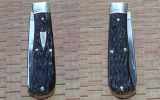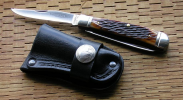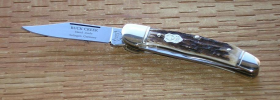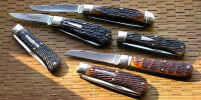There's an old 'How It's Made' video out there, about making pocketknives (linked below). It just happens to feature Case's production process. In part of the video, they show that the jigging done on the handle covers is actually done BEFORE the covers are pinned to the knife, between the bolsters. And later in the video, they show the hafting process where they use high-speed, powered buffing wheels to smooth all the rough edges and blend it all in at the seams. I suspect, in that production example, the indentations in the bolsters at the intersection with deep jigging on the handle slabs are essentially buffed into the bolsters during that hafting process. In other words, it's not the jigging process itself that creates those indentations in the bolster edges.
For a time, I thought it was kind of odd in seeing those indentations in the bolsters meeting the jigging grooves. But in a way, I've grown to like the fact that the two edges are blended together at that transition. I sometimes look at unblended transitions between the bolster and jigging on other knives, and think to myself, I don't like the way that looks, with the abrupt 'cavity' in the jigging just off the crisp edge of the bolster. I realize it's a subjective, preferential thing and not everyone will view it the same way as I do. But the blending between the two doesn't really bother me anymore.
Video from 'How It's Made' is below:







